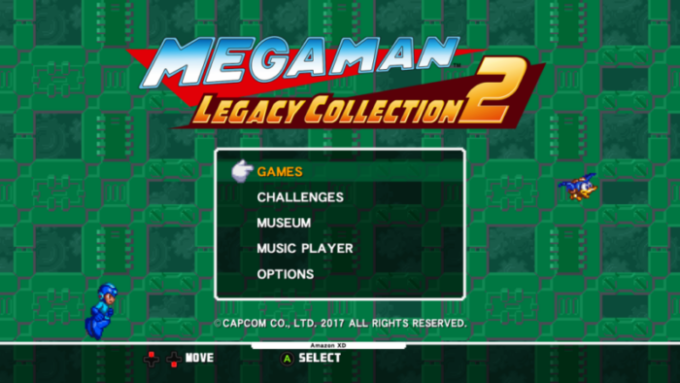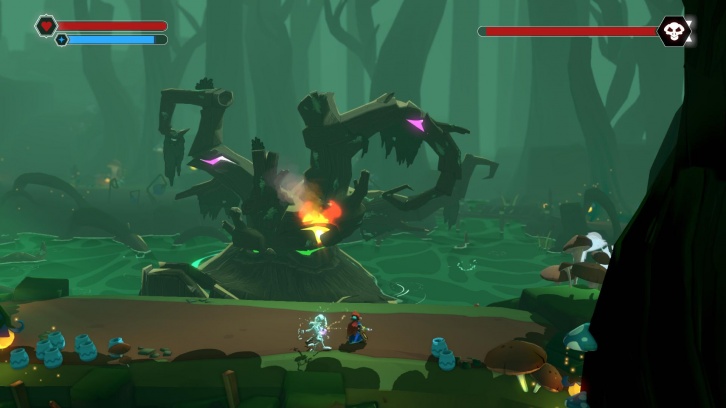As a huge fan of the original Mega Man series, I was absolutely blown away by the first Mega Man Legacy Collection. Besides being a compilation of great games (Mega Man 1 through 6), there was a healthy amount of extra content to sweeten the pot. Playing the games felt great, and some added features eased the difficulty. Both in service to veterans and newcomers, the original Legacy Collection did exactly what it set out to do. Mega Man Legacy Collection 2, on the other hand, is a rough collection of decent games, making it hard to have a final judgement. The games themselves may be enjoyable, but the container is a far cry from the retro glory of the original. Are these issues easy to overlook, or does the experience suffer from it?
Mega Man’s Big Change
Mega Man Legacy Collection 2 is comprised of four Mega Man titles. These Capcom developed games aren’t quite good enough to be considered “classics”, but are fun within their own right. Of them, Mega Man 7 and 8 represent the end of the original run of the series, with 9 and 10 representing the revitalization.
Originally released for the Super Nintendo (and a few other systems), Mega Man 7 and 8made noticeable changes to the original formula. These changes come with their own strengths and weaknesses. The main gameplay arc is still the same; Mega Man takes on a number of enemy robot bosses and amasses a collection of cool weapons. You jump and shoot through numerous themed stages, culminating in said boss fight. It’s a tried and true formula, and this remains the same with some small changes.
Bright and Colorful
I won’t spend the time covering each game in its entirety, as they’ve been out for a while and you can easily find in-depth coverage on each one. Instead, I’ll simply point out the big differences. Mega Man 7 is cheery and bright, and while some people remark on its difficulty, I never found it too frustrating. The visual style is very different from the original NES series, with a distinct cartoon look. While this is nice to look at and provides some color, the change also marks a noticeable switch in play as well. Level design is a bit more loose, and while platforming challenges are still the focus, gun play gets amped up a bit. Unfortunately, while the weapons you will unlock are interesting, the boss fights themselves can be uninspired.
The same goes for Mega Man 8, which ramps up the cartoon visuals. Including full-motion cartoon cut scenes and questionable voice acting, 8 is the black sheep of the numbered series. Normally short stages become multi-level affairs, and new gameplay variety makes a mark. In addition to running and blasting, 8 includes some shoot-em-up sections on a flying version of your robot dog. Furthermore, some sections of the game have you hopping on a jet board version of said dog, dodging obstacles and flying through the level. The sense of speed is impressive, but the gameplay is not. Everything looks pretty good to play, but isn’t quite as riveting or interesting as the original series.
Return to Retro
On the flip side, Mega Man 9 and 10 return to the series’ roots. Although originally released in the late 2000s, well after Mega Man X and other games had redefined the series’ look, 9 and 10 brandish the distinct 8-bit style of the NES. Mega Man 9 is the most pure in this regard, resembling something closer to Mega Man 1 or 2. There’s no fancy sliding or sliding, stripping away most of the additions made around Mega Man 3 and 4. Difficult platforming makes a noticeable return, and although it’s very fun to play, Mega Man 9 can be incredibly frustrating.
The same goes for Mega Man 10, which too resembles an NES game. 10 is more colorful and detailed than 9, and I enjoy the style and visuals the most of any in the collection. However, it never quite reaches the gameplay purity of 9. Mega Man 9 and 10 are excellent games, and round out the collection. The games themselves are generally fine, with only one noticeable issue. Before boss battles, all four games saw a major freeze that would happen on occasion. The game would lock up for 5 to 10 seconds before loading in the boss animation. A few times, I was convinced my game had crashed.
Missing Pieces
Here’s where the real issues lie with Mega Man Legacy Collection 2. It’s not that the games are bad; no, the games here play just fine. It’s the absolutely mediocre attempt at forming something special. In the original Mega Man Legacy Collection, the menus were engaging and fun, inciting nostalgia. Legacy Collection 2 is stale and boring, and the game mainly serves as a way to load four Mega Man titles. Museum content makes a return, hosting a large collection of concept art and boss designs. This stuff is still interesting to look at, and the inclusion of it is appreciated, but doesn’t make up for a few glaring exclusions. All the downloadable content from 9 and 10 is included, but the content we truly want is not.
The original Legacy Collection used save states to ease difficulty. Instead of relying on infrequent checkpoints in an already difficult series, you could easily save and load anywhere, anytime. For some unknown reason, Mega Man Legacy Collection 2 removes that ability, replacing it with a cheap “checkpoint” system that barely functions different from the ones in the original games. While this does allow you to replace your lives and not have to worry about getting a game over, it’s nothing compared to the accessibility of save states. While I didn’t have too many issues with Mega Man 7 or 8, I would’ve appreciated the feature in 9 and 10. Newcomers to the series, or worse, new fans spurred on by the original Legacy Collection, will have a much rougher time.
The Bottom Line on Mega Man Legacy Collection 2
Mega Man Legacy Collection 2 is a collection of two decent games and two good ones. It’s also a competent collection of art work and development-stage content to look at. However, the charm and heart in the original Legacy Collection just isn’t here. Save states have been replaced with a barely useful checkpoint system, nostalgia-inducing creative presentation is all but gutted, and it shows. Extra challenges were once a forefront and defining feature, and now, they feel tacked on and only included based on expectation.
Mega Man Legacy Collection 2 feels hollow; it doesn’t celebrate the games or open them to a new audience, it more or less just allows you to play them. There’s well over 50 hours of play here, but if you’ve already played the titles included, Mega Man Legacy Collection 2doesn’t offer much to incite a replay. However, for the price of $20, it’s hard not to recommend four serviceable Mega Man titles. Generally speaking, if you’re a huge fan of Mega Man, you’ll probably be happy with a purchase. If you have no prior love for the series, save your cash. It’s not amazing, it’s not terrible, it’s just okay. That’s mainly because the games themselves are a decent time.







